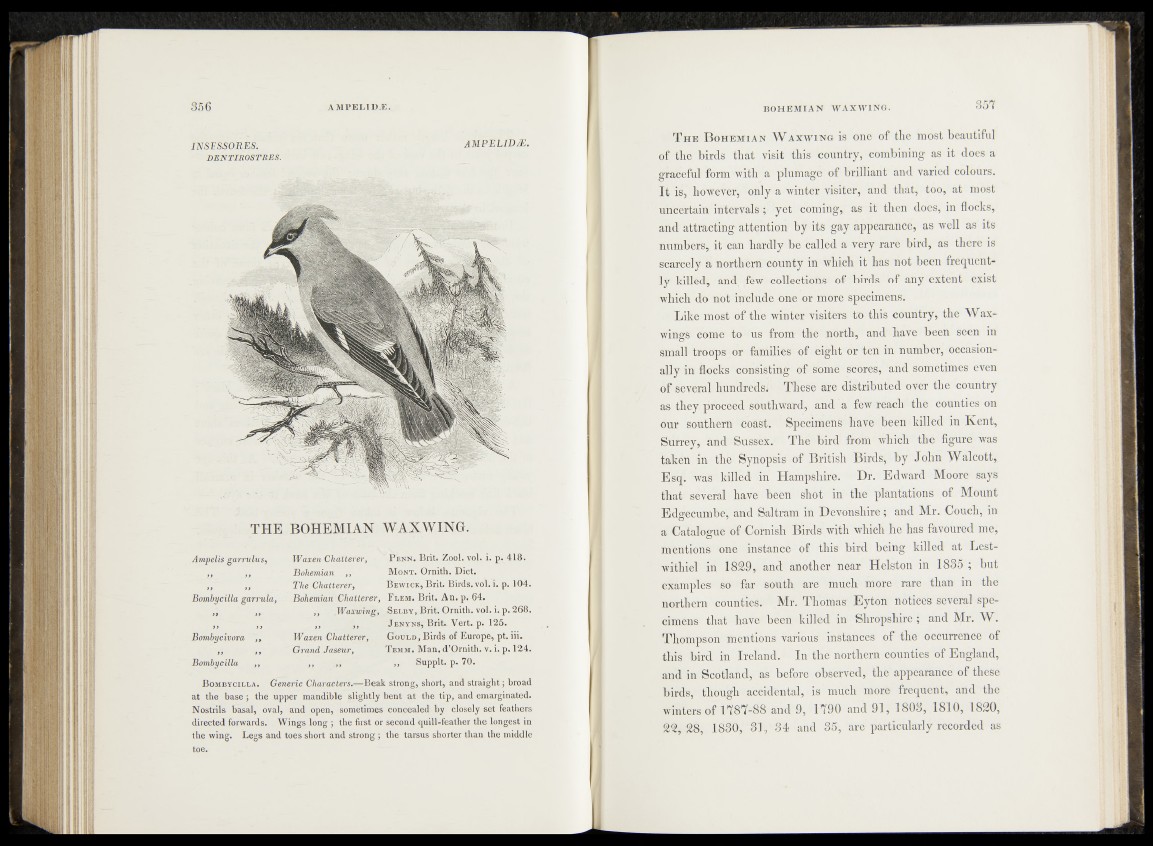
INSESSORES.
DEN TIROSTRES,
AMPELIDAE.
TH E BOHEMIAN W A XW IN G .
Ampelis garrulus,
Bombycilia garrula,
Bombycivora ,,
Bombycillu ,,
Waxen Chatterer, P enn. Brit. Zool. vol. i. p. 418.
Bohemian ,, M ont. Ornith. Diet.
The Chatterer, B ewick, Brit. Birds, vol. i. p. 104.
Bohemian Chatterer, F lem. Brit. A n . p. 64.
,, Waxwing, Selby, Brit.,, ,, Ornith. vol. i. p. 268. J enyns, Brit. Vert. p. 125.
Waxen Chatterer, Gould, Birds of Europe, pt. iii.
Grand Jaseur, Temm. Man. d’Ornith. v. i. p. 124.
,, ,, > y Supplt. p. 70.
B ombycilla. Generic Characters.—Beak strong, short, and straight; broad
at the base ; the upper mandible slightly bent at the tip, and emarginated.
Nostrils basal, oval, and open, sometimes concealed by closely set feathers
directed forwards. Wings long ; the first or second quill-feather the longest in
the wing. Legs and toes short and strong ; the tarsus shorter than the middle
toe.
T he B ohemian W axwing is one of the most beautiful
of the birds that visit this country, combining as it does a
graceful form with a plumage of brilliant and varied colours.
It is, however, only a winter visiter, and that, too, at most
uncertain intervals ; yet coming, as it then does, in flocks,
and attracting attention by its gay appearance, as well as its
numbers, it can hardly be called a Very rare bird, as there is
scarcely a northern county in which it has not been frequently
killed, and few collections of birds of any extent exist
which do not include one or more specimens.
Like most of the winter visiters to this country, the Wax-
wings come to us from the north, and have been seen in
small troops or families of eight or ten in number, occasionally
in flocks consisting of some scores, and sometimes even
of several hundreds.1 These are distributed over the country
as they proceed southward, and a few reach the counties on
our southern coast. Specimens have been killed in Kent,
Surrey, and Sussex. The bird from which the figure was
taken in the Synopsis of British Birds, by John Walcott,
Esq. was killed in Hampshire. Dr. Edward Moore says
that several have been shot in the plantations of Mount
Edgecumbe, and Saltram in Devonshire; and Mr. Couch, in
a Catalogue of Cornish Birds with which he has favoured me,
mentions one instance of this bird being killed at Lest-
withiel in 1829, and another near Helston in 1835 ; but
examples so far south are much more rare than in the
northern counties. Mr. Thomas Eyton notices several specimens
that have been killed in Shropshire; and Mr. W.
Thompson mentions various instances of the occurrence of
this bird in Ireland. In the northern counties of England,
and in Scotland, as before observed, the appearance of these
birds, though accidental, is much more frequent, and the
winters of 1787-88 and 9, 1790 and 91, 1805, 1810, 1820,
22, 28, 1830, 31, 34 and 35, are particularly recorded as